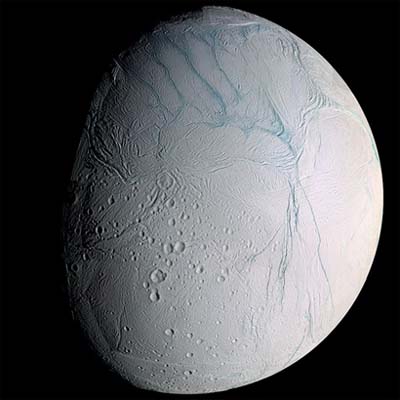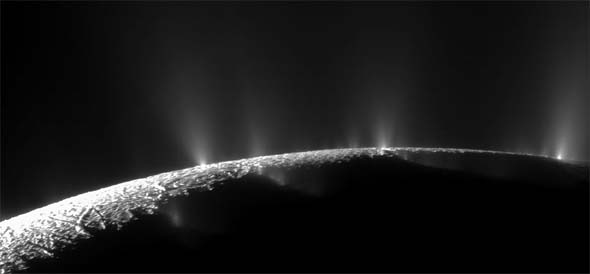 A
Liquid Ocean in the Strangest Place: Enceladus
A
Liquid Ocean in the Strangest Place: Enceladus
|

The
Southern hemisphere of Saturn's moon Enceladus photographed
by the Cassini space probe. (NASA)
|
On August 28, 1789, Sir William Herschel focused
his 47 inch (1.2-meter) telescope on a small dot in the sky near
the planet Saturn. Observing its motion, Herschel concluded that
this tiny object was an undiscovered moon of the ringed planet.
This little moon, which would later be named Enceladus, has become
of great interest to scientists in recent years because it seems
to be one of the few locations in our solar system, outside planet
Earth, that might harbor life.
Enceladus, with a diameter of 310 miles (500km),
is the sixth-largest moon of Saturn and orbits the planet every
33 hours at an average distance of 147,909 miles (238,037 km)
. Like most moons of Saturn it is named for one of the titans
in greek mythology. This makes sense as the leader of the titans
was Cronus (whose Roman name was Saturn). Now Enceladus and the
other titan-named moons of Saturn follow their king eternally
along his orbit.
A Shiny
Mystery
Astronomers have been intrigued by Enceladus because,
unlike most moons, it reflects 90% of the light that hits it,
making it one of the brightest objects in the solar system. It
took many years for them to figure out just why this happened,
but when the Voyager 2 space probe took pictures of the moon as
it passed by it in 1981, the mystery was solved. Scientists realized
that Enceladus had a much smoother surface that they expected.
Most moons are scarred with huge craters which are remnants of
the early solar system when collisions with meteors and comets
were common. The largest crater on this moon, however, is only
22 miles wide. This makes scientists suspect that the moon is
geologically active and has recently resurfaced itself with fresh,
clean ice. It is this smooth ice that reflects the light off of
Enceladus' surface so well. The fact that there is so much recently
formed ice on this moon makes them also suspect that there is
a significant amount of liquid water under a frozen crust of ice.
|
Seven
Quick Facts
|
| What
it is: The 6th largest moon of the planet Saturn. |
| Discovered:
August 28, 1789, by Sir William Herschel. |
| Size:
310 miles (500km) in diameter. |
| Orbit
147,909 miles (238,037 km) in the planet's E-ring:
|
| Brightness:
Its surface of fresh ice makes the moon the shiniest thing
in the solar system, reflecting 90% of the light that falls
on it. |
| Activity:
The moon has geysers that shoot liquid water into space. |
| Other:
The moon is believed to have a liquid water ocean under
its icy crust and may be the only place that might be able
to sustain life in the solar system besides Earth. |
While Enceladus' surface doesn't have very many
big craters, it does have a number of extensive linear cracks.
This would seem to be consistent with a surface that was geologically
active and remaking itself.
Geysers
Erupt into Space
The idea that there was liquid water on the moon
was confirmed when the Cassini space probe flew by it in 2005.
The probe observed over a hundred geysers erupting on the surface
of the planet along a set of fissures with a "tiger-striped" pattern
(a process called cryovolcanism). Some of the water vapor from
these geysers gives the moon a thin atmosphere that most moons
of this size do not have. The rest of it seems to contribute to
the material in the "E-ring" of Saturn. The E-ring is one of the
outermost rings of Saturn and is composed of tiny ice crystals,
unlike the inter-rings which are mostly made of larger chucks
of rock. Enceladus orbits in the center of the E-ring.
Studies from Cassini checking the density of the
moon in different areas suggest that the source of this cryovolcanism
is probably an ocean about the size of Lake Superior and around
10 km (6.2 miles) deep under Enceladus' southern hemisphere.
How does Enceladus manage to have a liquid ocean
in the freezing depths of space? Scientists believe that the powerful
gravity of Saturn causes the rocky core of the moon to stretch
and heat up. This, along with some radioactively in the core makes
heat that then raises the temperature under the surface ice enough
to melt it. At times the crust of the moon, especially near its
south pole, fractures under stress and some of the sub-surface
water of the moon is ejected creating the geysers observed by
the Cassini probe.
Cassini was able to determine that mixed into the
moon's salty water was nitrogen (in the form of ammonia), along
with nutrients and organic molecules, including trace amounts
of simple hydrocarbons such as methane, propane, acetylene and
formaldehyde. The presence of these materials along with a source
of heat raises the possibility that microbial life may have formed
in the moon's underground ocean.
Scientists believe life needs three things to form:
first a source of energy, second, a rich chemical background and
finally, a consistent source of liquid water. Enceladus is the
only place in the solar system, besides Earth that we know for
sure has these things (scientists also suspect Jupiter's moon
Europa might have them, too, but the evidence isn't there yet).
Does that mean that Enceladus has some kind of life
in its cold ocean? Until scientists figure out how to send a probe
that can land and drill down to that sea to take samples, we probably
won't know. Until that time what might be swimming in this tiny,
shiny moon's, underground ocean will remain a tantalizing mystery.
|
The
geysers erupting from the "Tiger Stripes" of the
southern hemisphere. (NASA)

|

Copyright Lee Krystek
2015. All Rights Reserved.





